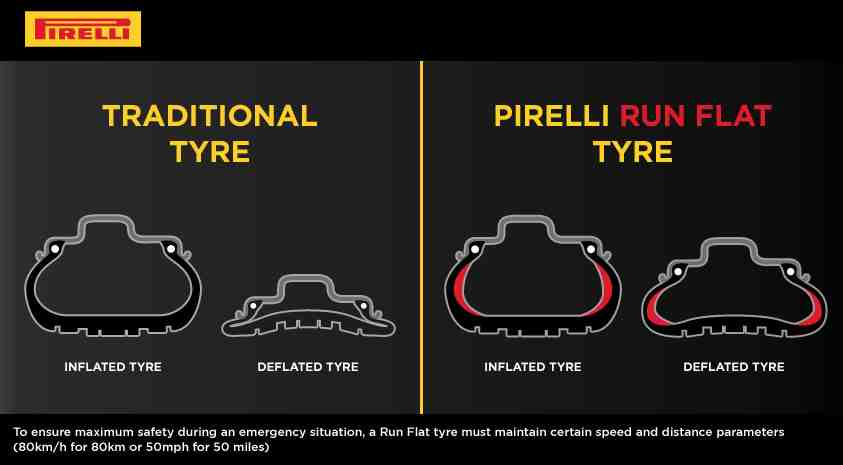Run flat tyres are specially designed to keep working for a short while even after they suffer a puncture.
How do they work?
Run flat tyres are built with reinforced sidewalls. Normally, a car is supported by the air in your tyres, and once you have a puncture, they collapse. However, run flat tyres have tough rubber inserts which temporarily hold up the weight of your vehicle even after a puncture.

How long can you drive on a punctured run flat tyre?
Once a run flat tyre suffers a puncture, you can’t keep driving on it forever – usually you will be able to drive at 50 km/p for 80km, but the exact range depends on variables like your driving speed, load of your vehicle and driving conditions.
Vehicles fitted with Run Flat as ‘Original Equipment’ (OE)
An increasing amount of vehicle manufacturers are opting to fit new cars with run flat tyres – so when you buy, for example, a new BMW 5 series or Mini, then it will come with four run flat tyres. This means that it will not have a spare tyre or tyre changing equipment included as standard.
Fitting ‘Conventional’ Tyres to a Run Flat Equipped Vehicle
If your car was originally supplied with Run Flat tyres, then it is possible to change to ‘conventional’ tyres. However, if the vehicle was designed with Run Flat tyres in mind, bear in mind you could be left stranded without a spare! Make sure you also buy a new spare tyre and tyre changing equipment.
Why change from run flat to conventional tyres?
We do not recommend changing the type of tyre your vehicle was originally supplied with. Changing to normal tyres could affect the handling of your car, however, some people choose to do this for the following reasons:
- Conventional tyres are generally cheaper than run flat tyres and have better availability
- Some drivers find that conventional tyres give a smoother, less bumpy ride than run flat tyres
- Generally, repairs aren’t carried out on a run flat tyre following a puncture
How to identify run flat tyres?
You can identify whether your tyres are run flat by inspecting the tyre sidewall. Unfortunately, there is not a standard code used for run flat tyres and different tyre manufacturers use different symbols. Please see the table below for the run flat codes for specific tyre manufacturers.
| Brand | Run Flat Tyre Descriptions | Technical Enquiry No |
|---|---|---|
| Bridgestone | RFT (Run flat Tyre) | 01926 488 595 |
| Continental | SSR (Self Supporting Run Flat | 01788 552 937 |
| Dunlop | DSST (Dunlop Self Supporting Tyre) | 01902 327 070 |
| Goodyear | EMT (ExtendedMobility Tyre) | 01902 327 070 |
| Michelin | ZP (Zero Pressure) | 0845 366 1535 |
| Pirelli | Tyre identified as a “Run Flat” tyre | 0870 240 9996 |
Fitting Run Flat to an older vehicle (‘retro fitting’)
If you are considering changing to run flat tyres on a vehicle that was previously fitted with ‘normal’ tyres, then there are several points to consider:
- Tyre Pressure Monitoring System
Run flats must only be installed on a car which has TPMS/tyre pressure monitoring system. TPMS alerts the driver to a puncture so they are aware that they have a limited time to replace their tyre, and so they drive within the limits of their deflated tyre (see our section on tyre-pressure for more detail) - Vehicle Suspension
You should also note that you may need some changes made to your vehicle’s suspension. Because of their stiffer construction, run flat tyres contribute to a vehicle’s suspension when fitted as original equipment.
Mixing Conventional Tyres with Run Flat Tyres
As a general rule of thumb, you should avoid mixing different tyre types on a vehicle. This is also true of combining conventional and run flat tyres on a car – as their handling characteristics may differ, they should not be mixed on a vehicle.
Mixing Different Tyre Brands
Again, it is the case that different brand tyres can have different handling characteristics, so you should follow the advice of the tyre manufacturer if you plan to mix different brands of tyres (this is also the case with conventional tyres). We would always recommend fitting the same brand and type of tyre across the axles of the vehicle, i.e. so both front tyres match each other.
Life span of Run Flat Tyres
The materials used to manufacture run flat tyres are similar or identical to conventional tyres, so their wear rates should be comparable. Keeping the correct air pressure in your tyres (no matter what type) is the best way to ensure a longer life from your tyres.
